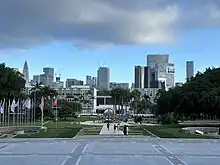 | |||||||||||
| Motto | 自立,自律,自强 | ||||||||||
|---|---|---|---|---|---|---|---|---|---|---|---|
Motto in English | Self-reliance, Self-discipline, Self-improvement | ||||||||||
| Type | Public | ||||||||||
| Established | September 27, 1983 | ||||||||||
| Endowment | ¥1.11 billion (2019)[1] | ||||||||||
| Budget | ¥6.08 billion (2020)[2] | ||||||||||
| President | Mao Junfa | ||||||||||
| Vice-president | Du Hongbiao, Xu Chen, Wang Hui, Li Yonghua, Zhang Xueji | ||||||||||
| Party Secretary | Li Qingquan | ||||||||||
Academic staff | 3,776 | ||||||||||
| Students | 35,455 | ||||||||||
| Undergraduates | 28,674 | ||||||||||
| Postgraduates | 6,433 | ||||||||||
| Location | , , | ||||||||||
| Campus | Suburban, 2.90 km2 (1.12 sq mi) | ||||||||||
| Colors | Lychee Red[3] | ||||||||||
| Affiliations | Guangdong-Hong Kong-Macao University Alliance (GHMUA) | ||||||||||
| Mascot | Li-Li (励励)[4] | ||||||||||
| Website | szu.edu.cn en.szu.edu.cn | ||||||||||
| Chinese name | |||||||||||
| Simplified Chinese | 深圳大学 | ||||||||||
| Traditional Chinese | 深圳大學 | ||||||||||
| |||||||||||



Shenzhen University (SZU, Chinese: 深圳大学) is a municipal public research university in Shenzhen, Guangdong, China. The university is funded by the Shenzhen Municipal People's Government.
SZU ranked 10th in the world for Nature Index 2021 Young Universities (Leading 150 Young Universities)[5] and 48th in the Asia-Pacific region for Nature Index 2023.[6]
Location
SZU comprises two campuses, Houhai campus and Xili campus, occupying 2.72 square kilometers in total. The Houhai campus is located on the coastline of Houhai Bay with 1.34 square kilometers. The new Xili campus now under construction is located in the city's University Town and takes up 1.38 square kilometers.[7]
History
Shenzhen University was established as a full-time comprehensive university, in line with the aim of China's Ministry of Education (MOE) to further develop the critical infrastructure in the Special Economic Zone of Shenzhen with strong support from Chinese leading universities including Peking University, Tsinghua University and Renmin University of China.[7]
Professor Zhang Wei, who was the former vice-president of Tsinghua University, an Academician of the Chinese Academy of Sciences and the Chinese Academy of Engineering, was appointed its first president of to develop it.
Shenzhen University has had a favored status in China's political and academic circles. Deng Xiaoping gave his personal approval to the university and Jiang Zemin penned the university's characters in his own hand. The university has been visited by several heads of state, scientists and researchers such as Nobel Prize winner in Physics Dr. Yang Zhenning. Many business and academics have made donations to support the development of Shenzhen University and some entrepreneurs have set up funds and scholarships in various disciplines. In 1995, Shenzhen University passed the teaching evaluation for the undergraduate program accredited by MOE, and was among the first group of universities in China to have its undergraduate programs certified. In 1996, Shenzhen University was accredited by the Academic Degree Evaluation Committee of the State Council for Master's programs. In 1997, Shenzhen University reorganized into the faculty and college structure, adopted a work-study program and committed to an integrated approach to teaching.

Since 2017, the university has concentrated on research-oriented teaching and has invested heavily in providing state of the art research laboratories. In 2017, the research budget totaled 9,705,000 million RMB. In 2006, three faculties were accredited to offer PhD degrees.
Administration
Faculty departmental structure
SZU now has 27 schools (colleges), providing 96 undergraduate majors, 38 first-grade master's degree conferring disciplines; 18 professional master's degree conferring disciplines and 10 first-grade doctoral degrees.[8]
| Normal College | School of Humanities | School of Foreign Languages | School of Media and Communication |
|---|---|---|---|
|
|
|
|
| College of Economics | College of Management | Law School | College of Design |
|
|
|
|
| College of Materials Science and Engineering | College of Physics & Energy | College of Chemistry and Environmental Engineering | College of Mathematics and Statistics |
|
|
|
|
| College of Information Engineering | College of Computer Science & Software Engineering | School of Architecture and Urban Planning | College of Civil Engineering |
|
|
|
|
| College of Mechatronics and Control Engineering | College of Electronic Science and Technology | College of Life Sciences and Oceanography | College of Optoelectronic Engineering |
|
|
|
|
| Health Science Center | College of Psychology and Sociology | Institute for Advanced Study | Shenzhen Audencia Business School |
|
|
|
|
| College of Entrepreneurship | College of Continuing Education | College of International Exchange | Graduate School |
| Tokyo College[9] |
Staff
The faculty consists of 3455 staff. There are 2267 teachers, 561 technicists, 627 administrative staff, 782 postdoctoral, 220 full-time researchers, 119 visiting professors, 228 foreign teachers. It has seven academicians in the Chinese Academy of Engineering, and 10 academicians in both the Chinese Academy of Sciences and the Chinese Academy of Engineering.
Research
The university is the main research center of Shenzhen city. It produced 846 SCI cited papers in 2014. The university teaching and research faculty had 356 works authored, 35 of which were translated into various languages. In addition, two technical inventions won the second prize in the National Technical Invention Competition, and one was awarded the first prize in the provincial invention competition. There were 26 research papers and projects which won prizes for science and innovation awarded by the People's Liberation Army as well as various research achievement prizes above the provincial level. 48 inventions and innovations from Shenzhen University have been marketed and 281 inventions have been adopted.
| Research Institution's | |||
|---|---|---|---|
| China Center for Special Economic Zone Research | Research Centre for Language & Cognition | ||
| Collaborative Innovation Centre for Optoelectronic Science and Technology | Center for Media and Social Changes | Center for China's Overseas Interest | Key Laboratory For Advanced Manufacturing Technology for Mold & Die |
| Institute for Urban Planning Design & Research | Institute for Nano Surface Science & Engineering | Institute for Cultural Industries | Immigration Culture Research Centre |
Library
Shenzhen University library holds a collection of 51202 million items (including Phase I project of Xili campus library), consisting of 4,007,900 million paper resources and there are 257 kinds of databases, which include 2,325,500 full-text e-books in Chinese and foreign languages and 124,800 e-journal are accessible via personal computers and Internet library terminals. The campus has 30,000 Internet connections and 99 percent of its classrooms and lecture halls have been digitized.
Students
Currently, SZU has 34,949 full-time students including 27,564 undergraduates, 7132 postgraduates, 253 doctors, 837 international students, 1340 part-time postgraduates and 18784 adult education students.
It has granted diplomas to 2,000 graduates from the Hong Kong and Macao Special Administration Regions as well as Taiwan. Shenzhen University has also established "dual-campus" joint-programs for undergraduate degrees with institutions in Great Britain and other foreign countries. There are up to 2,500 students that graduated from these joint programs since the university's inception, and the quality of programs has been accredited by the British Council. Shenzhen University participates with annual exchanges students and teachers with its sister universities in the United States of America, Great Britain, Japan, and South Korea.
Rankings and reputation
As of 2023, Shenzhen University was ranked # 151–200th by the Academic Ranking of World Universities and No. 271 globally by the U.S. News & World Report Best Global University Ranking.[10] The 2023 CWTS Leiden Ranking ranked Shenzhen University 126th in the world by total publications and 135th in the world based on the number of their scientific publications belonging to the top 1% in their fields for the time period 2018–2021.[11]
Nature Index
Nature Index tracks the affiliations of high-quality scientific articles and presents research outputs by institution and country on a monthly basis. SZU ranked 10th in the world for Nature Index 2021 Young Universities (Leading 150 Young Universities).[5] It ranked 111th in the world,[12] and 48th in the Asia-Pacific region for Nature Index 2023.[6]
| Year | Rank | Valuer |
|---|---|---|
| 2021 | 10[5] | Nature Index 2021 Young Universities (Leading 150 Young Universities) |
| 2023 | 48[13] | Nature Index – Academic Institutions – Asia-Pacific |
| 2023 | 111[14] | Nature Index – Academic Institutions – Global |
| 2023 | 37[15] | Nature Index – Academic Institutions – China |
Affiliated schools
- The Affiliated High School of Shenzhen University (深圳大学师范学院附属中学)[16]
See also
References
- ↑ Zhao, Deguo; Yanhou, Cai; Dang, Yaru (2019). 2019中国大学评价研究报告 (1st ed.). Beijing: Science Press (China). ISBN 9787030604972.
- ↑ As of FY 2020. "Departmental budget of Shenzhen University in FY 2020" (PDF). General Office of Shenzhen Municipal People's Government. Retrieved March 30, 2020.
- ↑ "Shenzhen University Logo". Retrieved March 30, 2020.
- ↑ "我校举办校园吉祥物发布会-深圳大学". szu.edu.cn. Shenzhen University.
- 1 2 3 "Leading 150 young universities – Nature Index 2021 Young Universities – Supplements – Nature Index". Nature Index. Retrieved February 5, 2023.
- 1 2 "2023 tables: Institutions – academic | Annual tables | Nature Index". Nature. Retrieved July 18, 2023.
- 1 2 "About-Shenzhen University (SZU)". en.szu.edu.cn. Retrieved September 27, 2022.
- ↑ "Undergraduate Programs-深圳大学英文站". en.szu.edu.cn. Retrieved April 5, 2019.
- ↑ "深圳大学東京校(中国名:東京学院)公式ホームページ – 中国有名総合大学の学位を取得できる". Retrieved April 5, 2023.
- ↑ "2023 Best Universities in the World – US News Shenzhen University". US News. October 25, 2022. Retrieved July 18, 2023.
- ↑ Studies (CWTS), Centre for Science and Technology. "CWTS Leiden Ranking". CWTS Leiden Ranking. Retrieved July 18, 2023.
- ↑ "2023 tables: Institutions – academic | Annual tables | Nature Index". Nature. Retrieved July 18, 2023.
- ↑ "2023 tables: Institutions – academic | Annual tables | Nature Index". Nature. Retrieved July 18, 2023.
- ↑ "2023 tables: Institutions – academic – Annual tables – Nature Index". Nature Index. Retrieved August 9, 2023.
- ↑ "2023 tables: Institutions – academic – Annual tables – Nature Index". Nature Index. Retrieved July 22, 2023.
- ↑ "The Affiliated High School of Shenzhen University". Shenzhen Municipal Government. Retrieved February 14, 2022.
Add: 0353 Qianhai Road, Nanshan District, Shenzhen (深圳市南山区前海路0353号)
External links
- Shenzhen University Official Website (English)
- Shenzhen University Official Website (in Chinese)
- Shenzhen University Tokyo College
- University in Turmoil: The Political Economy of Shenzhen University by Michael Agelasto (1998) ISBN 962-86141-1-8
- Educational Disengagement: Undermining Academic Quality at a Chinese University by Michael Agelasto (1998) ISBN 962-86141-2-6
- "English Evangelism: A Tool for the New Century Mission". A former SZU teacher discusses her missionary work.

.svg.png.webp)